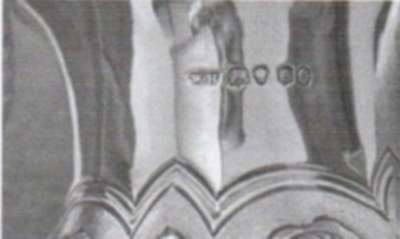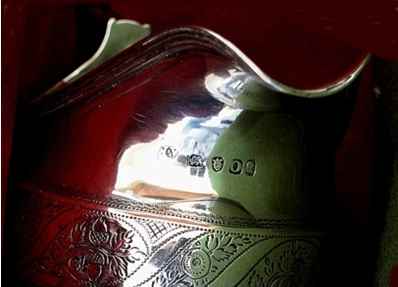A SMALL COLLECTION OF ANTIQUE SILVER |
| an article of David McKinley, for ASCAS - Association of Small Collectors of Antique Silver |

|
(click on photos to enlarge image)THE DOUBLE MARK PUNCH
|
 |
'double mark' in the
form of a date letter
|
'Duble (sic) marks' were again mentioned in the mark book
entry for 1788 and were for use on rings. Observation of the
mark plate shows that this time the mark took the form of the
duty head followed by the lion.
In 1789, according to the mark book, this punch was used on
buttons, rings and knife hafts and in 1790 there are two
references to it; one for rings and the other unqualified.
Observation shows that this second punch was used on tea tongs (sugar
tongs) and this is useful for dating tongs as this is the only
year in which they were marked in this way since a fly press
mark, for marking tongs, came into use in 1791. Note that the
outline to the lion is now rectangular with canted top corners
and an ogee base.
Although the double mark punch introduced in 1788 was still
being produced in 1792, at this stage it must have been for use
on buttons only as in that year both rings and knife hafts were
being marked by means of the press with a triple mark which was
of this same format but with the addition of the date letter at
the end of the sequence.
By 1792 it had become obvious that double mark punches could be
of great use in the marking of all sorts of other plate and in
that year two other double mark punches were introduced; one
with the lion followed by the leopard, which is in a Norman 'kite'
shield with canted top corners, and the other with date letter
followed by the duty mark.
 |
 |
Goblet by William
Hewitt London 1837/8 showing use of two
|
Not only were these marks used on some hollow ware, on the curved surfaces of which the press could not be used, but they proved most useful in the marking of plate for which the usual marks were not appropriate.
The image below shows the marks on a sterling standard
teaspoon of the same date for comparison.
Recognition of these double marks can be of considerable
assistance to the collector in, for instance, determining the
date of a piece. Photo below is of a milk jug by Andrew
Fogelberg and has the date letter "O" for either 1789/90 or
1809/10. Close examination of the marks reveals that, whereas
the lion and leopard marks have been individually punched, the
date letter and the duty mark have been applied by means of a
double mark punch so that the jug must have been assayed after
1792. Its assay date is, therefore, 1809/10.
 |
Milk jug by Andrew
Fogelberg London 1809/10 showing that
|
By the turn of the century the idea of the double mark punch
was well established and in 1813 a unique and rather delicate
little mark was introduced for marking pendants on which no duty
was payable. This took the form of a double diamond or lozenge
in the first half of which was the date letter and in the second
the sterling lion. This mark appears not only to be unique in
its design but is also smaller than any other mark that I have
yet come across. I imagine that it is also somewhat uncommon.
By 1818 a double mark punch comprising a lion within a rectangle
with canted top corners and an ogee base followed by a date
letter within a similar outline had also been introduced in two
sizes but there is no indication on the mark plate that it was
to be used in combination with another double mark punch and it
may, therefore, have been intended for partial marking.
NB: Hollow ware such as tea pots and caddies were marked
underneath at this time and the marks were thus still hand
punched in clock face fashion since such pieces could not be
accommodated in a fly press.
ACKNOWLEDGEMENT
I am greatly indebted to the Worshipful Company of Goldsmiths
for extending to me research facilities.
Some of the information in this article was first published
under the title "The Introduction of Double Mark Punches" in
"The Finial" (the journal of The Silver Spoon Club of Great
Britain) in June/July 2003).
By 1818 a double mark punch comprising a lion within a rectangle with canted top corners and an ogee base followed by a date letter within a similar outline had also been introduced in two sizes but there is no indication on the mark plate that it was to be used in combination with another double mark punch and it may, therefore, have been intended for partial marking.
NB: Hollow ware such as tea pots and caddies were marked underneath at this time and the marks were thus still hand punched in clock face fashion since such pieces could not be accommodated in a fly press.
ACKNOWLEDGEMENT
I am greatly indebted to the Worshipful Company of Goldsmiths for extending to me research facilities.
Some of the information in this article was first published under the title "The Introduction of Double Mark Punches" in "The Finial" (the journal of The Silver Spoon Club of Great Britain) in June/July 2003).
|
David McKinley David McKinley devotes much of his time to researching the history of silversmithing in England with particular reference to hallmarking at the London office.He writes for The Silver Spoon Club of Great Britain, The Silver Society and ASCAS website. David McKinley is the author of the book THE FIRST HUGUENOT SILVERSMITHS OF LONDON. |
 www.silvercollection.it |
|
This is a page of A Small Collection of
Antique Silver and Objects of vertu, a 1500 pages richly illustrated website offering all you need to know about
antique silver, sterling silver, silverplate, Sheffield plate, electroplate silver,
silverware, flatware, tea services and tea complements, marks and hallmarks, articles,
books, auction catalogs, famous silversmiths (Tiffany, Gorham, Jensen, Elkington),
history, oddities ... HOME - SITE MAP - SILVER DICTIONARY - COOKIES CONSENT AND PRIVACY OTHER ARTICLES ABOUT: ANTIQUE SILVER SILVER PLATE ENGLISH SILVER FRENCH SILVER |


